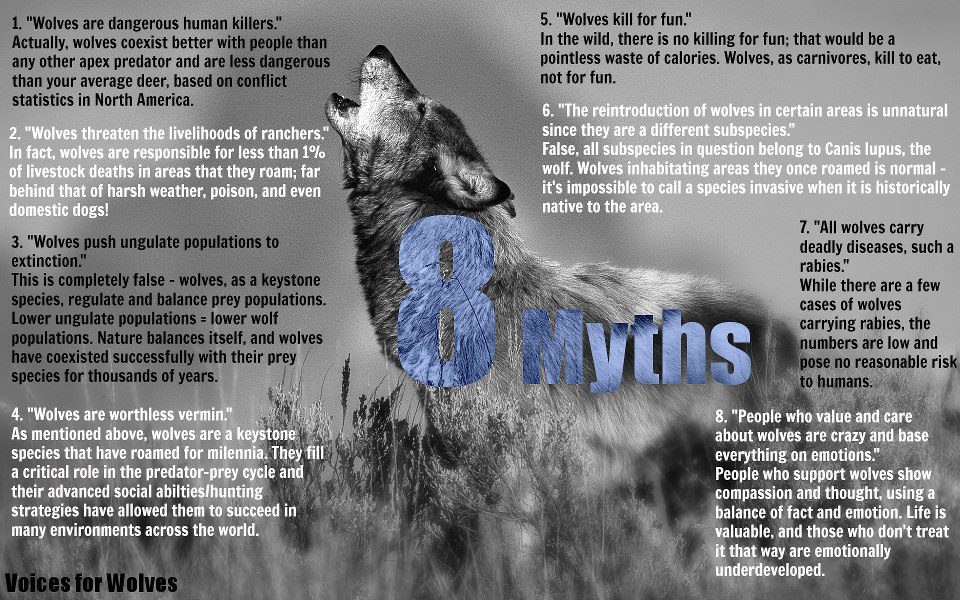
The wolf is not so scary … 6 myths about wolves
Since childhood, we have been hearing that wolves are predators that will kill everyone who gets their teeth. Even in the lullaby, it is sung that some gray top must certainly bite the child on the side. But is the wolf as scary as we used to think, and what to do if you meet a handsome gray man in the forest?
Photo: wolf. Photo: flickr.com
Contents
- Myths and facts about wolves
- Myth 1: An encounter with a wolf is deadly for humans.
- Myth 2: All wolves are rabid
- Myth 3: Wolves are only found in wilderness areas.
- Myth 4: Wolves surround people’s houses, howl at night and hold a siege
- Myth 5: Wolves get into barns and destroy pets.
- Myth 6: Because of the wolves, the population of ungulates suffers: elk, roe deer, etc.
- What to do when meeting with a wolf?
Myths and facts about wolves
Myth 1: An encounter with a wolf is deadly for humans.
This is not true. For example, the statistics of Belarus, where there are a lot of wolves, shows that over the past 50 years, not a single person has died from the attack of this predator. For a wolf, in principle, it is not typical to attack people, this is not part of his habit. Moreover, they try to stay as far away from people as possible and avoid contact with them by all means. Wolves often see people, but remain invisible to them.
Myth 2: All wolves are rabid
Indeed, rabid animals are found among wolves. However, this is not the rule, but the exception. If a dangerous epidemiological situation arises, the Ministry of Health speaks about it. And in this case, when walking in the forest, care must be taken: rabid animals are controlled, alas, by disease.
By the way, wolves get rabies less often than raccoon dogs or foxes.
Myth 3: Wolves are only found in wilderness areas.
Wolves in the forest like to lie near the paths trodden by people: this is how they observe and control what is happening. However, this does not mean that they prey on people: they will not follow a person and approach him. However, a young wolf may follow a man out of curiosity, but still will not come close.
Photo: wolf. Photo: pixabay.com
Myth 4: Wolves surround people’s houses, howl at night and hold a siege
This behavior of wolves is found only in fairy tales and fantasy stories. Wolves will not surround a man’s dwelling, much less hold a siege.
Myth 5: Wolves get into barns and destroy pets.
Wolves do not like buildings and generally enclosed spaces. Even in abandoned cowsheds, where there are no doors, wolves do not enter. But animals that people have left unattended (in particular, dogs that roam the neighborhood in search of food) can indeed become victims of hungry wolves.
Although wolves do not usually hunt near human habitation, there are individuals that “specialize” in domestic animals. However, this only occurs where there is very little “natural” prey for the wolves. But this is the fault of the person who destroys ungulates. If there are enough wild ungulates, wolves will hunt them and will not approach human habitation.
Another way to “lure” wolves to human habitation is illiterately organized cattle burial grounds, landfills and other places where food waste accumulates. That is also the fault of man.
Myth 6: Because of the wolves, the population of ungulates suffers: elk, roe deer, etc.
The population of ungulates suffers due to the fault of man – in particular, because of poachers or because of uncontrolled hunting. Wolves are not able to critically reduce the number of elk, roe deer or deer. Proof of this is the Chernobyl zone, where moose and deer – the main prey of wolves – feel very good, although there are many wolves there.
In the photo: a wolf. Photo: flickr.com
What to do when meeting with a wolf?
“When meeting with a wolf, you need to rejoice,” experts joke. After all, it is not so often you can meet this beautiful and cautious beast.
But if you still see a wolf, just calmly go the other way, do not run, do not make sudden movements that may seem threatening to the animal, and everything will be all right.
The wolf is not as scary as we used to think about it.





